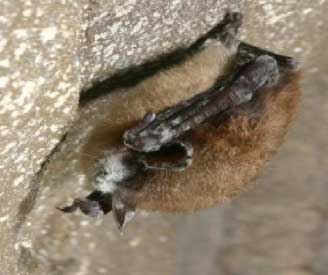White Nose Syndrome
Geomyces destructans
Protect our bats by not disturbing them. Never approach or handle a bat. Learn what you can do to help bats here.
Description
This is a disease in hibernating bats caused by the fungus Geomyces destructans. The disease gets its name from white fungus that appears on the muzzle and other body parts of infected bats. The fungus causes skin erosion and abnormal bat behavior leading to death. The disease causes bat mortality through abnormal behavior during winter hibernation months including flying outside during the day and clustering near the entrances of caves. These behaviors deplete the bat’s fat stores causing death due to the elements. The disease primarily affects winter hibernating bats.
THere are 13 species of bats that have been recorded in Nebraska learn more here. The following bat species are most effected by the fungus: Big brown bat, Eastern small-footed bat, Indiana bat (Endangered species), Little brown bat, Northern long-eared (Threatened species) and the Tricolored bat. Learn more about white nose syndrome in Nebraska here.
Habitat
Bat winter hibernation roosts including caves and mines.
Location in Nebraska
Was confirmed in an abandoned mine in Cass county, Nebraska in 2015 View location map.
Pathway of Introduction and Spread
The disease was first found in New York City in the winter of 2007. The disease came to the United State from Europe. The disease is spread from bat to bat contact.
Impacts
The disease is estimated to have caused bat population declines in the northeastern US since it emerged at approximately 80%. Bat species affected by the disease are unlikely to recover quickly due to long life spans and only birthing a pup per year.

